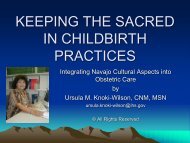Ethical Space for a Sensitive Research Topic - National Aboriginal ...
Ethical Space for a Sensitive Research Topic - National Aboriginal ...
Ethical Space for a Sensitive Research Topic - National Aboriginal ...
You also want an ePaper? Increase the reach of your titles
YUMPU automatically turns print PDFs into web optimized ePapers that Google loves.
keeping with the PAR model. The community partners were<br />
very receptive and many looked <strong>for</strong>ward to assisting with the<br />
job description.<br />
DISCUSSION<br />
The goal of the community visits was to continue the<br />
building of relationships between community stakeholders<br />
and researchers, beyond the <strong>for</strong>malities of presentations<br />
at regional chiefs’ meetings and development of research<br />
agreements. We strongly believe that getting to know each<br />
other through respectful, personal, face-to-face dialogues<br />
be<strong>for</strong>e beginning the actual project helped foster trust and<br />
facilitated crucial knowledge exchange between the research<br />
team and community members. This approach was met<br />
with great interest and openness toward the project at the<br />
community level. Many important research aspects were<br />
successfully negotiated during these community visits. Study<br />
logistics and HPV-related themes were the most prominent<br />
topics discussed, but other, more sensitive issues were raised<br />
such as sexual abuse and drug use and their perceived<br />
association with shame and stigma related to HPV.<br />
The research team learned first-hand that participating<br />
communities face significant differences in accessing<br />
screening services, despite their close political associations,<br />
cultural connections, and relatively close geographical<br />
locations. Gaining a thorough understanding of these<br />
disparities was important and in<strong>for</strong>med the research plan.<br />
The research design now addresses how this phenomenon<br />
may affect screening participation in the larger study and<br />
how accessibility of services and the invasiveness of a pelvic<br />
exam may pose barriers to screening. Access to health care<br />
services offering Pap smears varies tremendously among<br />
participating communities. In some communities they<br />
are provided locally by a visiting physician, but women in<br />
other communities have to resort to services in the next<br />
larger town with travel times ranging from 15 minutes to<br />
three hours. First Nations-based Women’s Wellness Clinics<br />
offering health education, breast exams, and Pap smears<br />
are frequently not sustainable in participating communities<br />
due to limited health services budgets. Pap test results of<br />
women who receive their test outside of the community<br />
are not reported back to the First Nations health centre,<br />
disrupting continuity of care. A desired research outcome <strong>for</strong><br />
communities there<strong>for</strong>e includes the enhancement of access<br />
<strong>for</strong> local screening and increased community capacity to<br />
monitor screening and to support follow-up when required.<br />
<strong>Ethical</strong> <strong>Space</strong> <strong>for</strong> a <strong>Sensitive</strong> <strong>Research</strong> <strong>Topic</strong><br />
The researchers learned further important lessons <strong>for</strong> the<br />
research design. For example, it is impracticable to research<br />
the previous screening history of First Nations women due<br />
to (a) the lack of comprehensive screening records at the<br />
local First Nations health centres, (b) the lack of provincial<br />
electronic cervical cancer screening databases in Ontario,<br />
and (c) the fact that cervical cancer screening is still not part<br />
of an organized cancer screening program in this province.<br />
There was a shared interest to raise community<br />
and health provider awareness of HPV infection and<br />
transmission in general, as well as HPV vaccines and<br />
testing. Community stakeholders suggested that culturally<br />
based prevention approaches <strong>for</strong> STIs should be developed<br />
simultaneously with the research project implementation.<br />
For example, one could explore incorporating HPV<br />
prevention in traditional teachings provided by Elders<br />
to young girls. Many questions related to study logistics<br />
were negotiated and often resolved, including the health<br />
centre’s role in recruitment and other research activities,<br />
inclusion criteria <strong>for</strong> women to participate in the study, and<br />
handling of HPV tests. Community partners also provided<br />
suggestions <strong>for</strong> questionnaire domains and requested<br />
the inclusion of sexual behaviour and history questions,<br />
psychological factors, environmental factors, and health<br />
history. There was also an interest to address HPV in the<br />
context of First Nations health services, health budgets<br />
and medical transportation, the broader impact of the<br />
residential schools experiences on HPV infection, and<br />
cervical cancer screening. A strong emphasis on protecting<br />
the confidentiality and privacy of participating of women<br />
emerged as another priority in the research design. This<br />
has resulted in the adjustment of our research protocol to<br />
allow women the choice of having test results sent to their<br />
First Nations health centre or alternatively to be contacted<br />
by an off-reserve mainstream health provider. Sexuality,<br />
residential school attendance, sexual abuse, and drug use<br />
have been identified as important factors <strong>for</strong> the researchers<br />
to consider, as these may have an impact on some women<br />
and contribute to behaviours that might increase the risk of<br />
HPV infection. Multiple partners, early sexual experience<br />
(consensual or non-consensual), smoking, childbirth rates,<br />
and psychological stress were also perceived as potential risk<br />
factors.<br />
In our future research, we hope to explore the possible<br />
multi-generational nature of these issues and how they<br />
may be connected with low screening, avoidance of Pap<br />
testing, fear of cervical cancer, and lack of trust of health<br />
care providers per<strong>for</strong>ming Pap tests. Alternatively, the<br />
self-collected HPV test we propose to further test in our<br />
Journal of <strong>Aboriginal</strong> Health, March 2012 47






